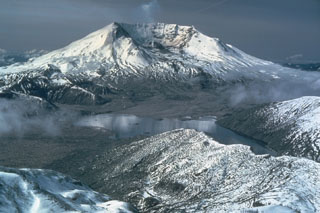Report on St. Helens (United States) — April 1984
Scientific Event Alert Network Bulletin, vol. 9, no. 4 (April 1984)
Managing Editor: Lindsay McClelland.
St. Helens (United States) Mud flow and vertical plume
Please cite this report as:
Global Volcanism Program, 1984. Report on St. Helens (United States) (McClelland, L., ed.). Scientific Event Alert Network Bulletin, 9:4. Smithsonian Institution. https://doi.org/10.5479/si.GVP.SEAN198404-321050
St. Helens
United States
46.2°N, 122.18°W; summit elev. 2549 m
All times are local (unless otherwise noted)
Deformation, seismicity, and gas emission declined to background levels after the end of the extrusion episode that began in late March (SEAN 09:03). More than half of the April earthquakes were recorded on the 1st. Seismicity reached background level 3 April and remained low through early May. Deformation was very slow through early May. Rates were roughly half the background values measured before deformation began to accelerate prior to the March extrusion episode. Maximum rates were 6 mm/day on the SE side. However, at some points on the dome, no outward movement was measured. Three single-axis telemetering tiltmeters installed along a radial line at 50, 250, and 750 m N of the dome recorded little tilt in April. SO2 emission averaged 85 ± 50 t/d in April.
. . . On 14 May at 0932 seismicity in the crater began to increase. A pronounced increase was detected at 0935 and a great increase at 0937. No plume was visible at 0934, but by 0939 a plume had risen to an altitude estimated at 5.5-6 km by ground observers. Airplane pilots reported that the eruption cloud had reached 7.5 km altitude at 0950 and 10.5 km at 1000-1005. Radar at Portland airport measured an elevation of 6 km at 0940. Light ashfall was reported at Mt. Rainier National Park, 65 km to the NNE.
In addition to a vertical plume, cold to hot (but not molten) material was ejected laterally from the upper SW portion of the dome. Some cleared the rim of the crater and fell on the outer W flank of the volcano. However, much of the fragmented dome material struck the W wall of the crater, melting heavy snow that had accumulated there during the winter. A flow consisting of about 90% snow and 10% sand-sized lithic fragments plus a few blocks to 1 m in diameter moved through the [crater and the] breach N of the crater. Near the crater, the flow was about 200 m wide. In the outer half of this zone, some melting occurred, but there was little erosion of the underlying snow. Deposits were typically 0.5-1 m thick but locally reached 2 m in thickness. The inner half of the zone was dominantly erosional. Approximately the outer 10 m of the erosional section consisted of fluted snow covered by a lag deposit of fine lithics a couple of centimeters thick. Most of the erosional section was eroded down to [1980 deposits]. The initial flow was apparently primarily snow, followed by [a slushy flow] and then (in the erosional zone) by [a watery flow].
The flow divided into two branches [on the pumice plain (on the volcano's N flank)]. The NE branch . . . reached Spirit Lake (about 5.5 km from the crater) at 0955. The main (NW) branch, a mudflow, entered the North Fork of the Toutle River. Addition of water to the flow caused degeneration to a hyperconcentrate (exhibiting Newtonian behavior, a transition that typically occurs when water concentration reaches about 30% of the flow by weight) by the time it reached Coldwater Lake (about 12 km from the crater). It reached the lake at 1020, carrying boulders to 2 m in diameter, but peak flow there did not occur until 1100. At N-1 debris dam (about 30 km from the crater), peak flow was 135 m3/s above background. Peak flow had attenuated to 27 m3/sec at the mouth of the North Fork (about 90 km from the crater).
Geological Summary. Prior to 1980, Mount St. Helens was a conical volcano sometimes known as the Fujisan of America. During the 1980 eruption the upper 400 m of the summit was removed by slope failure, leaving a 2 x 3.5 km breached crater now partially filled by a lava dome. There have been nine major eruptive periods beginning about 40-50,000 years ago, and it has been the most active volcano in the Cascade Range during the Holocene. Prior to 2,200 years ago, tephra, lava domes, and pyroclastic flows were erupted, forming the older edifice, but few lava flows extended beyond the base of the volcano. The modern edifice consists of basaltic as well as andesitic and dacitic products from summit and flank vents. Eruptions in the 19th century originated from the Goat Rocks area on the N flank, and were witnessed by early settlers.
Information Contacts: D. Peterson, T. Casadevall, D. Childers, N. MacLeod, C. Mullins, B. Myers, P. Otway, USGS CVO, Vancouver, WA; R. Norris, University of Washington; M. Matson, NOAA/NESDIS; NWS, Portland, OR.

